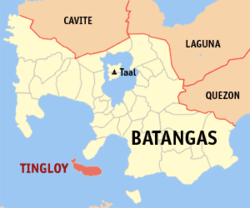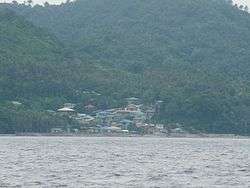Tingloy, Batangas
| Tingloy | |
|---|---|
| Municipality | |
|
A fishing village on the eastern side of Tingloy | |
 Map of Batangas showing the location of Tingloy | |
.svg.png) Tingloy Location within the Philippines | |
| Coordinates: 13°39′N 120°52′E / 13.65°N 120.87°ECoordinates: 13°39′N 120°52′E / 13.65°N 120.87°E | |
| Country | Philippines |
| Region | CALABARZON (Region IV-A) |
| Province | Batangas |
| District | 2nd District |
| Founded | 1890 |
| Barangays | 15 |
| Government[1] | |
| • Mayor | Mark Laurence F. Alvarez |
| Area[2] | |
| • Total | 33.07 km2 (12.77 sq mi) |
| Population (2015 census)[3] | |
| • Total | 17,919 |
| • Density | 540/km2 (1,400/sq mi) |
| Time zone | PST (UTC+8) |
| ZIP code | 4203 |
| Dialing code | +63 (0)43 |
| Income class | 5th class |
Tingloy is a fifth-class municipality in the province of Batangas, Philippines. According to the 2015 census, it has a population of 17,919 people.[3]
The municipality comprises Maricaban Island, Caban Island, and other minor islets, all just south of the Calumpang Peninsula. Visitors to its beaches and diving facilities are a source of income.
History
The name "Tingloy" was according to legend, derived from a plant of almost the same name. Nowhere in the whole Island could one find now in abundance the plant called "tinghoy".
The first people to inhabit the Island almost a century age today came from Taal and Bauan presumably to escape the brutalities perpetrated by the Spanish "conquistadors". They came in family groups and finding the place a real haven, settled down in definite areas later to prove themselves to be the nuclei of the various barrios now comprising the created political subdivision. It is said that the former barrio of Tingloy was founded by Jose Martinez, a Taaleño.[4]
At several times the island was placed under the jurisdiction of different towns. The island was originally part of the town of San Luis. In 1917, it was placed under the jurisdiction of Bauan only to be separated from it a year later and when the municipality of Mabini was formed. In 1921, it was again placed under the jurisdiction of Bauan.
During the Spanish regime people were educated at home learning to read the "Cartillas" and the "Caton" "Christiana". During American occupation schools were established. Mr. Ireneo Martinez together with Mr. Flaviano Gamben, initiated a movement for a model schoolhouse for the former barrio of Tingloy. This movement was crowned with the success when a model schoolhouse was constructed in the present poblacion of the Municipality of Tingloy sometime in 1921.[4]
During the second Regular Session of the third Congress of the Republic of the Philippines, Republic Act No. 1344 (House Bill No. 11), creating the Municipality of Tingloy was, approved. House Bill No. 11 was authored by the Hon. Numeriano U. Babao, Congressman for the Second District of Batangas. President Ramon Magsaysay, on June 17, 1955, appointed the first municipal Officials headed by Atty. Ramon De Claro as Mayor.
Geography
Just off the south-west coast of the Batangas mainland, about two nautical miles (3.7 kilometres) south, lies the radish-shaped Island of Maricaban. It has a land area of about 14 square miles (36 square kilometres) of rugged hills and sloping mountains with the occasional splatterings of lowland plains and a liberal springklings of valleys. The coastal perimeter of the island with green trees and clinging vines and sudden drops of stony mountains slopes is a real treat to the eyes. Spread all over the island are barrios of St. Tomas, Talahib, San Pedro, Gamao, Pisa, Corona, San Isidro, Papaya, San Juan, Macawayan, Maricaban, San Jose and Poblacion, the latest to become later the seat of government of the Municipality of Tingloy.
Barangays
Tingloy is politically subdivided into 15 barangays.[2]
| PSGC | Barangay | Population | ±% p.a. | ||
|---|---|---|---|---|---|
| 2015[3] | 2010[5] | ||||
| 041033001 | Corona | 4.8% | 861 | 870 | −0.20% |
| 041033003 | Gamao | 5.9% | 1,062 | 1,039 | +0.42% |
| 041033004 | Makawayan | 5.5% | 977 | 982 | −0.10% |
| 041033005 | Marikaban | 6.8% | 1,221 | 1,112 | +1.80% |
| 041033006 | Papaya | 9.7% | 1,747 | 1,732 | +0.16% |
| 041033007 | Pisa | 6.6% | 1,181 | 965 | +3.92% |
| 041033008 | Barangay 13 (Poblacion 1) | 4.9% | 876 | 794 | +1.89% |
| 041033009 | Barangay 14 (Poblacion 2) | 4.9% | 886 | 812 | +1.67% |
| 041033010 | Barangay 15 (Poblacion 3) | 4.8% | 867 | 722 | +3.55% |
| 041033011 | San Isidro | 9.4% | 1,686 | 1,459 | +2.79% |
| 041033012 | San Jose | 8.0% | 1,428 | 1,197 | +3.42% |
| 041033013 | San Juan | 10.7% | 1,916 | 1,821 | +0.97% |
| 041033014 | San Pedro | 2.7% | 477 | 527 | −1.88% |
| 041033015 | Santo Tomas | 9.3% | 1,673 | 1,677 | −0.05% |
| 041033016 | Talahib | 5.9% | 1,061 | 1,161 | −1.70% |
| Total | 17,919 | 16,870 | +1.16% | ||
Demographics
| Population census of Tingloy | ||
|---|---|---|
| Year | Pop. | ±% p.a. |
| 1990 | 15,430 | — |
| 1995 | 14,897 | −0.66% |
| 2000 | 17,028 | +2.91% |
| 2007 | 18,548 | +1.19% |
| 2010 | 16,870 | −3.39% |
| 2015 | 17,919 | +1.16% |
| Source: Philippine Statistics Authority[3][5] | ||
The population of Tingloy in the 2015 census was 17,919 people,[3] with a density of 540 inhabitants per square kilometre or 1,400 inhabitants per square mile.
Places of interest
- Masasa Beach (Barangay San Juan) is one of the most visited beaches of the place, and known for its white sand and beautiful sunset at the beach's tip of the coast. It is located in the other side of the Island which you can take by walk or tricycle.
- Mag-Asawang Bato is one of the two peaks of the island, and this is the most visited peak by mountaineers and nature enthusiasts, where a 360° view of the whole island can be seen.
- Isla Sombrero (Sombrero Island) is located at the eastern tip of Maricaban, Tingloy in the province of Batangas. It's a mini island paradise inhabited by no one. The island can be reached through a medium-sized motor-boat or banka. It is one of the most visited beach attractions in the island.
- Batalang-Bato (Pulang Buli) is a Fish Sanctuary between Barangay Sto. Tomas and Barangay Talahib. For research diving and snorkeling, you will need permission from the BBMC and the barangay councils of Sto. Tomas and Talahib.
- Caban Island is also considered as one of the tourist spots because of its white sand and scattered beaches surrounding the island. Among this is Mapating Beach, Layag Layag Point, Caban Island Beach, Fortales Beach, Bahay Kambing, and many more.
- Diving is also a major attraction because of different dive spots situated in the area. Tingloy is considered as the center of marine diversity not only the region but in the Philippines and in the whole world.
References
- ↑ "Official City/Municipal 2013 Election Results". Intramuros, Manila, Philippines: Commission on Elections (COMELEC). 11 September 2013. Retrieved 11 November 2013.
- 1 2 "Province: Batangas". PSGC Interactive. Makati City, Philippines: National Statistical Coordination Board. Retrieved 31 October 2012.
- 1 2 3 4 5 "Region IV-A (CALABARZON)". Census of Population (2015): Total Population by Province, City, Municipality and Barangay (Report). PSA. Retrieved 20 June 2016.
- 1 2 "TINGLOY TOWN", TINGLOY TOWN FIESTA SOUVENIR PROGRAM, 1979-10-18
- 1 2 "Region IV-A (CALABARZON)". Census of Population and Housing (2010): Total Population by Province, City, Municipality and Barangay (Report). NSO. Retrieved 29 June 2016.
| Wikimedia Commons has media related to Tingloy, Batangas. |
 |
Balayan Bay | Mabini Maricaban Strait |
 | |
| Isla Verde Passage | |
Batangas Bay / Batangas City | ||
| ||||
| | ||||
| Isla Verde Passage Puerto Galera, Oriental Mindoro |
